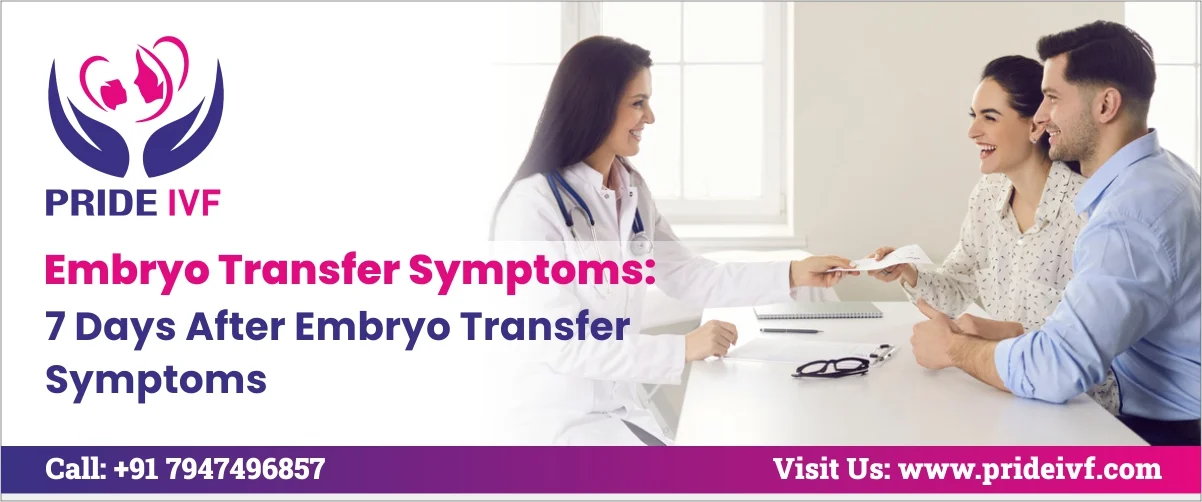Before we discuss about 7 days after embryo transfer symptoms, it is crucial to understand the process of embryo transfer. An embryo is gently inserted into a woman’s uterus during an embryo transfer, a critical stage of in vitro fertilization (IVF).
The frozen embryo transfer (FET) process is very easy to do and often takes around 30 minutes. Pride IVF is renowned as the best fertility clinic in Delhi, offering cutting-edge reproductive solutions and personalized care.




Embryo Transfer
Here is a list of the essential actions involved:
- Thawing the Embryo: With a ivf success rates of over 90%, the embryologist carefully thaws the frozen embryo.
- Preparing the Uterus: On the day of the FET, the woman’s uterus is prepared for the transfer, with an ultrasound verifying the ideal lining thickness.
- Transferring the Embryo: Embryo transfer is a painless technique that includes carefully inserting the embryo into the uterus lining with the use of a small catheter in the hopes that it will successfully implant and lead to pregnancy.
Also Read: after embryo transfer diet chart.
After Embryo Transfer Day By Day Symptoms
It’s important to remember that after embryo transfer, every woman’s experience is unique. However, here is a general day-by-day guide to the symptoms after embryo transfer:
Days 1-3: The Initial Period
- Mild cramps, light spotting, and exhaustion are frequent during the first several days following the embryo transfer. Usually, the surgery itself and the drugs taken during IVF treatment in delhi are blamed for these symptoms after embryo transfer.
Days 4-6: Window for implantation
- Some women may have implantation bleeding, which manifests as a pinkish or brownish discharge when the embryo begins to embed itself into the uterine lining. The pelvic region may also experience mild cramps or twinges at this time. It’s also possible to see a minor rise in basal body temperature. Also Read: When does implantation occur?
7 days onwards, Early Pregnancy Symptoms
- 7 days after embryo transfer symptoms may include those of an early pregnancy. These symptoms, which are brought on by hormonal changes and the growing pregnancy, might include breast pain, frequent urination, mood swings, and nausea. But it’s important to keep in mind that each person may experience these symptoms differently, and a pregnancy test is the most accurate way to determine whether you’re pregnant.
Lets get started
| Day | Symptoms |
| Day 1 To Day 2 | No specific symptoms |
| Day 3 To Day 4 | – Mild cramping |
| – Spotting | |
| Day 5 To Day 6 | – Cramping and bloating |
| – Spotting | |
| Day 7 To Day 8 | – Breast sensitivity |
| – Fatigue | |
| – Cramping and back pain |
7 Days After Embryo Transfer Symptoms
Implantation Bleeding
The embryo has probably already implanted itself in the uterus by day 7. This procedure occasionally results in implantation bleeding, which is a mild bleeding condition. This often lasts less time and is lighter than typical menstruation. Don’t be concerned if you don’t see any implantation blood because not everyone does. Also Read: Implantation symptoms.
..Light Cramping
Some people may feel a slight lower abdominal cramp or pain at this time. This occurs as a result of the embryo ingesting the uterine lining. Remember that not everyone has cramps, so don’t panic if you don’t.
Fatigue
As your body adjusts to the hormonal changes brought on by pregnancy, feeling weary is a normal symptom during this time.
Body Changes Following Embryo Transfer
Apart from the 7 days after embryo transfer symptoms, you may also notice a few physical changes as your body adjusts:
- Bloating: Fluid retention and bloating are side effects of hormone treatments used in IVF.
- Weight increase: Because of fluid retention or hormonal changes, some women may have modest weight gain.
- Enlarged breasts: Breast swelling and tenderness may increase when hormone levels fluctuate.
- Increased cervical mucus: As the body gears up for a potential pregnancy, an increase in cervical mucus production is a frequent shift following embryo transfer.
No Symptoms After Embryo Transfer
Don’t panic if you haven’t seen any of the aforementioned symptoms; 10 to 15% of women report feeling OK after their embryo transfer, and these side effects are frequently caused by a progesterone and estrogen combo.
It’s advisable to relax and refrain from interpreting positive feelings following an embryo transfer as either premenstrual symptoms or early pregnancy symptoms because they can be difficult to separate from one another. None of these symptoms should, however, be severe, and if they are, it’s crucial to get in touch with your clinic for more guidance.
Why Pride IVF?
If you’re seeking the best IVF center in Delhi, look no further than Pride IVF, where we prioritize your dream of parenthood with compassion and excellence.
For many infertility-affected couples, embryo transfer—more particularly, IVF frozen embryo transfer—is a crucial step on the road to motherhood. Making the experience less intimidating and more powerful may be accomplished by being aware of the ivf process step by step, anticipating what will happen on the day of the transfer, and being ready for the subsequent emotional and physical symptoms.
It’s crucial to keep in mind that while medical procedures naturally include some risk, Pride IVF has specialists who are highly skilled in assisted reproductive technologies, bringing you closer to starting your family.




